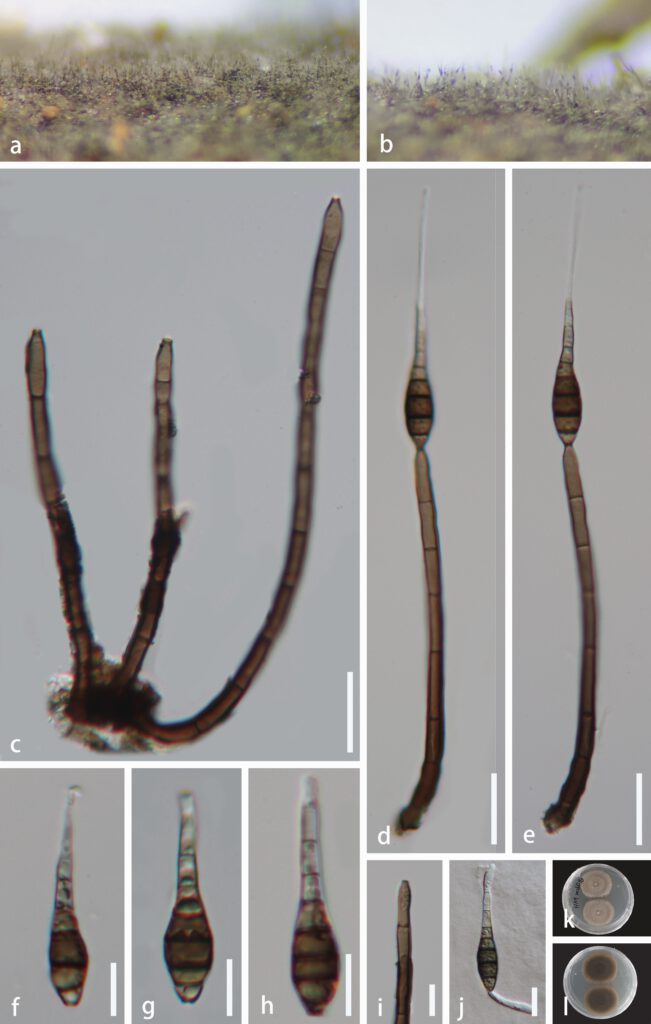Distoseptispora tropica J Ma, K. D. Hyde & Y.Z. Lu, sp. nov. (Figure 5).
MycoBank number: MB; Index Fungorum number: IF ; Facesoffungi number: FoF 11335;
Etymology: ‘tropica’ named after the climate from which the holotype was found.
Holotype: HKAS 123761
Saprobic on decaying wood submerged in terrestrial habitats. Sexual morph: Undetermined. Asexual morph: hyphomycetous. Colonies on decaying wood effuse, scattered or in small groups, gregarious, hairy, smooth, brown or dark brown. Mycelium mostly immersed, composed of branched, septate, smooth, brown to dark brown hyphae. Conidiophores 59.4–150.6 μm × 3.5–7.3 μm (x̅ = 93.9 × 5 μm, n = 20), macronematous, mononematous, cylindrical, erect, straight or slightly flexuous, unbranched, Smooth, thick-walled, smooth-walled, dark brown, solitary or caespitose, dark brown and rounded at the apex, paler brown at the upper, 5-7-septate. Conidiogenous cells 9.6–20.6 × 3.5–6.1 μm (x̅ = 159 × 4.7 μm, n = 20), holoblastic, monoblastic, terminal, integrated, cylindrical, pale brown or brown, smooth. Conidia 38.6–75.2 × 7.1–9.9 μm (x̅ = 47.3 × 8.1 μm, n = 30), acrogenous, verrucose, solitary, multi-distoseptate, obclavate, rostrate, upper part tapering towards the apex, guttulate, thick-walled, smooth-walled, olivaceous brown or dark brown, 5-7-distoseptate, with conspicuous hyphae attachment conidium, with a truncate base.
Culture characteristics: Conidia germinating on PDA within 12 h and germ tubes produced from conidia. Colonies growing on PDA, reaching 40 mm diam. after 40 days at 25°C, circular, flat, with dense, fluffy, grayish brown mycelium on the surface; in reverse dark brown.
Material examined: China, Hainan Province, Haikou city, Xiuying District, Ecological leisure trail, on decaying wood submerged in terricolous habitat, 10 August 2021, Jian Ma, HK9 (HKAS 123761, holotype; GZAAS22-0081, isotype), ex-type living culture, GZCC22-0076.
GenBank accession numbers: (LSU), (ITS), (TEF1α) ON, (RPB2) ON.
Notes: The morphology of Distoseptispora tropica is very similar to Distoseptispora, Ellisembia and Sporidesmium[2,6,7]. However, according to the phylogenetic result (Fig. 1) that shows D. tropica belongs to the genus Distoseptispora. D. tropica forms a sister clade to clade 1 with relatively well-supported values (76% ML and 1 BYPP). Following BLASTn searches of NCBI GenBank, the closest matches of the LSU, ITS, TEF1α and RPB2 sequences of D. tropica are Distoseptispora rayongensis (strain MFLU:18-1046, MH457138, 93.39% shared identity), Distoseptispora aquatica (strain S-965, MK828647, 79.76% shared identity), Distoseptispora tectonae (strain MFLUCC 12-0291, TEF1α, KX751710, 88.95% shared identity) and Distoseptispora obpyriformis (strain DLUCC 0867, MG988416, 80.27% shared identity), respectively. But the D. tropica morphology is different from other species of clade 1. Hence, we introduce the new collection of D. tropica as new species of the genus Distoseptispora.

Figure 5. Distoseptispora tropica (HKAS 123761, holotype) a–b Colonies on natural substrate. c Conidiophores bearing conidiogenous cells. d–e Conidiophores with attached conidia. f–h conidia. i conidiogenous cell. j Germinating conidium. k, l Culture on PDA from above and reverse. Scale bars: c–e = 20 μm, f–j = 10 μm
